Dolphins
Dolphins are aquatic mammals that fall into the category of other marine mammals such as manatees, seals, and whales. They swim in the water like other fish but are not themselves fish. They differ from fish and are placed in the mammal category due to their resemblance to them in a few prominent features.
Dolphins are warm-blooded aquatic animals. Unlike fish, they do not lay eggs; instead, they give birth to live young and produce milk for them like other mammals. They breathe through lungs, not gills. These characteristics are enough to classify them as mammals.
Scientific Classification of Dolphins
Kingdom | Animalia |
Phylum | Chordata |
Class | Mammalia |
Order | Cetacea |
Different Species of Dolphins
About 42 species of dolphins are known, divided among five families of marine mammals. These families are classified into two types. The largest one is the oceanic dolphin family, which includes 38 species, while the other four are classified as river dolphins, with each river dolphin family having only one species.
However, we are discussing some popular dolphin species.
Oceanic dolphins (Delphinidae)
General names & Species | Locations |
White beaked dolphin 6sp. | Found in subpolar to temperate waters of Northern Hemisphere, and in polar to temperate waters of Southern Hemisphere |
Stripped, spotted and spinner dolphin 5sp. | Worldwide in tropical to warm temperate waters |
Piebald dolphin 4sp. | In coastal waters of South America, southern Africa, and New Zealand |
Humpbacked dolphin 3sp. | Coastal, 1sp. In eastern Africa, India and western Pacific, 1sp. of western Africa, and 1sp. of northern Australia |
Pilot whale 2sp. | Worldwide in subpolar to tropical waters |
Right whale dolphin 2sp. | Found in cooler temperate waters, 1sp. In Northern Hemisphere and 1sp. in Southern Hemisphere |
Common, saddleback dolphin 2sp. | Worldwide in tropical to temperate waters |
Fraser’s dolphin 1sp. | Worldwide in tropical & subtropical waters |
Pygmy killer whale 1sp. | Same as above… |
Irrawaddy dolphin 2sp. | Found in coasts of eastern India, southeast asia, and northern australia |
Killer whale 1sp. (Orca) | Worldwide |
Risso’s dolphin 1sp. | Worldwide, from tropical to warm temperate waters |
False killer whale 1sp. | Same as above… |
Grey dolphin 1sp. | In coasts of tropical & subtropical eastern south America |
Melon headed dolphin 1sp. | Offshore, worldwide in tropical & subtropical waters |
Rough toothed dolphin 1sp. | Worldwide in deep tropical to warm temperate waters |
Bottlenose dolphin 3sp. (Most populated) | 1sp. Found worldwide in tropical to cold temperate waters, 1sp. Indian and Pacific oceans, 1sp. Off the coast in Southern Australia |
However, out of 37, we are discussing some popular dolphin species.
Bottlenose Dolphin
It is the most famous dolphin species in the world. They are gray in color and have a short rostrum. Found in the warm waters of the world, they hold a special place in human hearts due to their friendly nature.
Killer Whales
Also known as Orcas, these are the world’s largest dolphins. Known colloquially as killer whales, they weigh 11 tons and can be up to 30 feet long. They are recognizable by their black and white pattern.
Spinner Dolphins
These dolphins are aerial acrobats that attract nature lovers with their spins out of the water. The name “spinner” is derived from their acrobatic actions. They are found in both warm and shallow waters around the world.
Hourglass Dolphins
The hourglass dolphins, along with some other dolphin species, are rarely seen by the human eye and are found in the Antarctic region.
River dolphins (Platanistidae)
General Names & Species | Location |
Amazon River dolphin 1sp. | Found in Amazon & Orinoco river basins |
Indus River dolphin 1sp. (critically endangered) | Found in Indus river, Sindh, Pakistan |
Ganges River dolphin 1sp. | Found in Ganga, Brahmaputra, and Meghna rivers. |
South American dolphin 1sp. | In coasts of eastern South America |
China’s River dolphin 1sp. (Nearly extinct) | In China’s Yangtze River |
River dolphins are those found in fresh waters.
Boto Dolphin
The Amazon river dolphins are also called boto dolphins. It is one of the river species found in fresh waters. After maturity, their skin turned pink.
Ganges Dolphins
They are found in the fresh waters of the Ganges River in India. They are sideway swimmers, and this fact makes them unique.
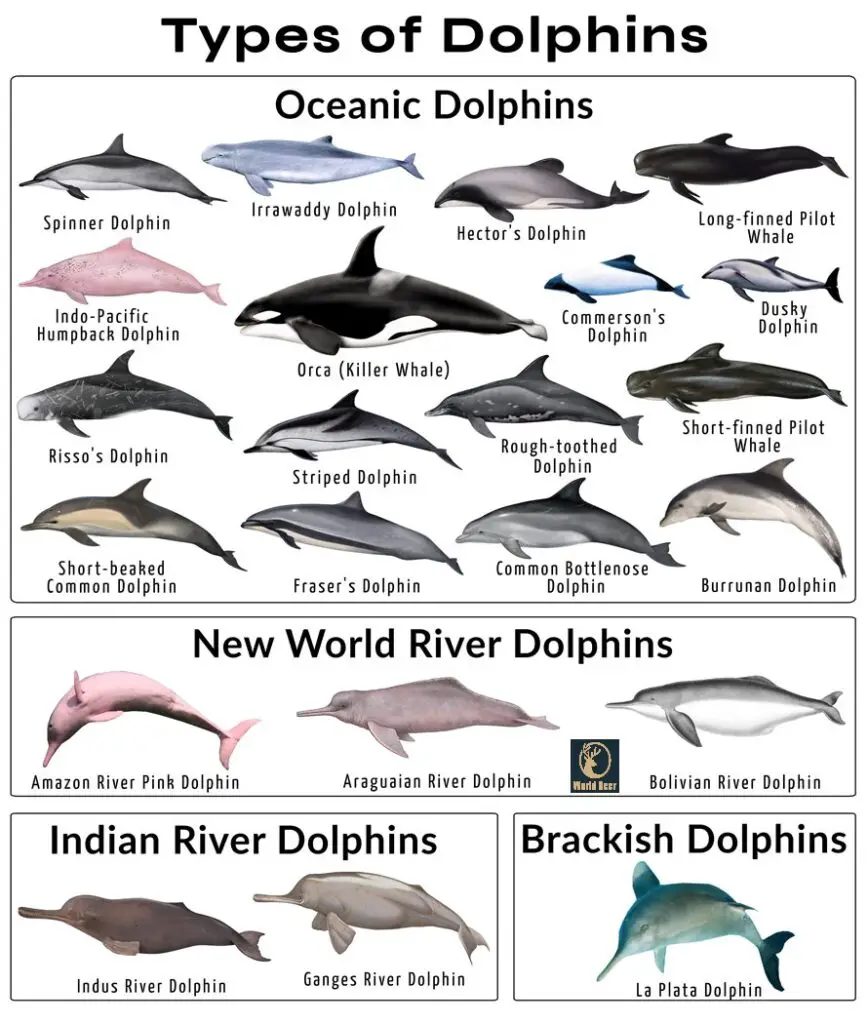
Physical Characteristics
Size and Weight: Sizes range from 1 meter to 30 feet across different species. Similarly, weights vary from 350 pounds to 11 tons.
Body: Each dolphin species has its own shape and size. However, a streamlined body is more common.
Melon and Rostrum: The rounded part of a dolphin’s forehead is called a melon and is crucial for echolocation. The rostrum, or a dolphin’s beak, includes its jaw and nasal cavity.
Dentition: Dolphins have conical teeth of regular shape and size, typically used to grasp slippery prey, not for grinding.
Fins and Fluke: A dolphin has three types of fins. Dorsal fins are located on both sides of the body, while pectoral fins are positioned on the back. The tail fin is known as a fluke.
Speed: On average, dolphins swim at a speed of 20 miles per hour.
Skin Coloration: Dolphins have rubbery skin in shades of grey, white, and black, with grey being the most common color and white bellies.
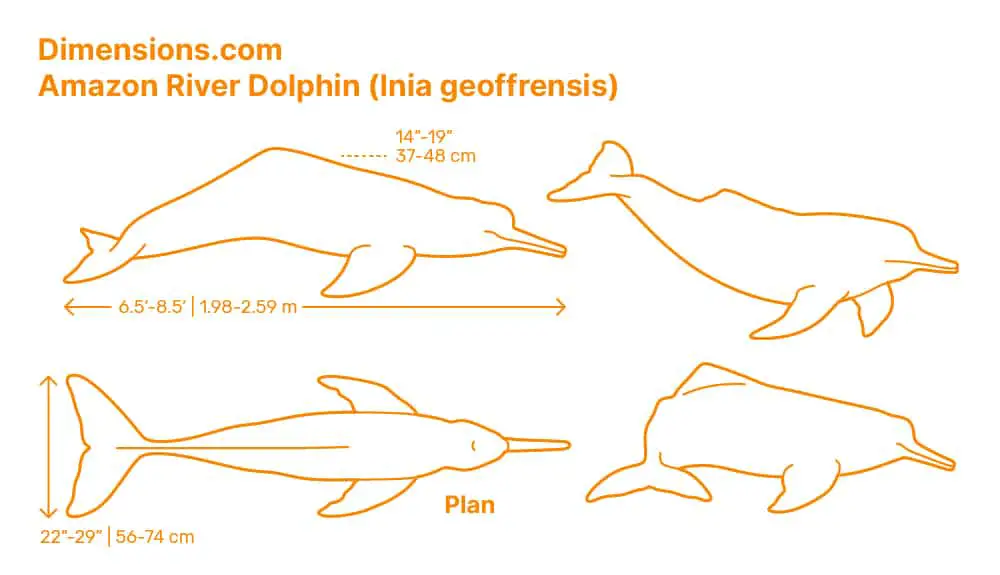
Dolphins size and Weight
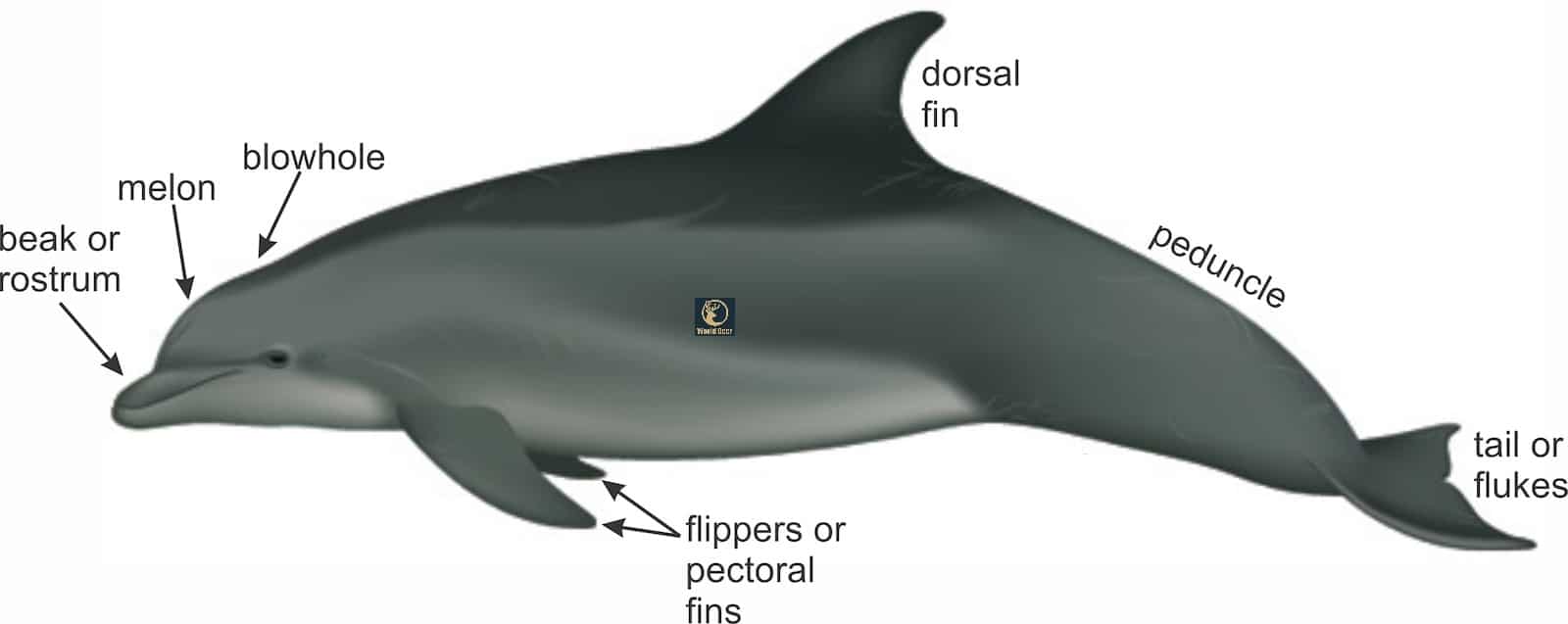
Dolphins Melon and Rostrum
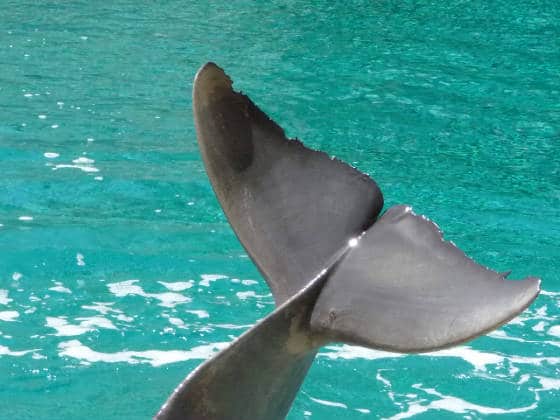
Dolphins Fins and fluke
Distribution and Habitat
Geographically, dolphins range from latitudes 50°S to 50°N. They are found in warm, tropical, and temperate waters. Dolphins are distributed among all the oceans and seas, except the Aral and Caspian seas.
- The Pacific Ocean
- The Atlantic Ocean
- The Indian Ocean
- Amazon River
- Indus River
- Other rivers and seas
They inhabit both offshore and nearshore waters. Offshore waters are outside the territorial boundaries, while nearshore is the coastal waters. Coastal waters are being polluted and habitat destruction also takes place.
Feeding and Hunting
Dolphins are carnivorous animals. They are active predators of fish, squids, shrimps, and other crustaceans. Offshore dolphins prefer to eat fish and squids, while nearshore dolphins favor fish and other invertebrates. A dolphin consumes 3 to 4 percent of its body weight per day.
Dolphins hunt sardines and other fish by forming pods. They chase the sardines over long distances and then herd them into tight clusters known as bait balls. This pursuit is also referred to as a sardine run. They also feed on individual fish.
Another feeding method is called crater feeding. Bottlenose dolphins dig their snouts into the sand to capture unseen fish. Other hunting techniques, such as driving and blocking, strand feeding, and pinwheeling, are employed by these aquatic creatures.
Behavioral Adaptations
Social Behavior
A group of dolphins is called a pod. A pod typically consists of 5 to hundreds of members. These small pods form larger groups called superpods, which can include up to 5,000 dolphins. They form pods primarily for foraging, protection, and other cooperative behaviors.
Even bonds lasting 20 years have been documented.
Raking
Raking is an aggressive behavior among dolphins, where they may scratch their teeth on one another’s bodies. These scratches can cause wounds that heal rapidly but leave permanent rake marks on their bodies. 84% of raking incidents come from juveniles and adult males, while the remainder are from females.
Communication and Echolocation
Dolphins communicate through vocalizations and echolocation. They produce various sounds like squeaks, whistles, clicks, and buzzes. Another term, breaching, is used when they splash the water with their bodies and tails. The older the dolphin bond, the better they can understand and mimic each other’s whistles.
Echolocation is a type of navigation that also facilitates communication, similar to sonar waves. These finned creatures emit sounds that travel a specific distance to listen for an echo. The echo is the sound that bounces back when a dolphin’s sound wave hits an object or another creature.
Migration
Some dolphins exhibit seasonal migration while others remain in their specific habitats. These migrations are often in response to the migration of prey fish and variations in water temperature. Some dolphins are found in estuaries during the winter, which are temperate water bodies rich with food fishes.
Reproduction and Parenting
The sexual maturity of a dolphin varies with its gender and geographical location. Females become sexually mature between 5 to 13 years, while males mature between 8 to 12 years. The gestation period varies between species, typically ranging from 10 to 18 months. They usually produce one calf at a time.
At birth, calves have hairs on their bodies, which may disappear as they reach maturity. Mother dolphins lactate their young with specialized physiology because nursing underwater is challenging. Calves depend on their mothers for several years. They may stay with their mother for their entire lives or venture off after a few years.
Lifespan
These naughty mammals have a life expectancy of about 30 to 40 years. Bottlenose can live for a maximum of forty years. Orcas, the largest dolphins known as killer whales, can live up to 60 years. However, lifespan varies for different species of dolphins.
Intelligence
These cute creatures of the aqua world are known for their intelligence, emotions, and social cognition. They have an advanced neocortex. It is the part of the brain responsible for problem solving and self awareness. They can learn, cooperate, and grieve as humans. Their communication skills are a bright part of their intelligence.
Interaction with Humans
In the beginning, human interaction with dolphins was limited to hunting. As humans learned about the social bonds and keen nature of dolphins, this interaction turned into friendship. Dolphins are also trained for military purposes, such as mine detection, due to their intelligence.
The Marine Mammal Authority (MMA) limits human-dolphin interactions as they sometimes result in conflict. It is also considered harassment of dolphins under US law. However, dolphins are still hunted for meat, leather, and oil, particularly in Japan.
Ecological Importance
Dolphins are one of the top predators in marine ecosystems. They prey on fish, jellyfish, squids, shrimps, and other invertebrates. Conversely, they are also prey for large predators like sharks and whales. In this way, the dolphin’s niche helps maintain the balance of the marine food chain.
They contribute to the safety of other marine life and humans. By preying on sick or injured fish, they help eliminate infectious diseases among fish populations. Dolphins also aid scientists and researchers in learning more about the secrets emerging from the ocean floor.
Economic Importance
These friendly creatures play an important role in both ecology and the economy. Lovina, Bali in Indonesia derives significant economic benefits from dolphin watching. It attracts about 37,000 tourists annually, supporting boat tour operators by providing earnings above their average income.
In many other coastal areas, ecotourism offers economic benefits and enhances people’s appreciation for marine wildlife. It also provides job opportunities for the local community and becomes a significant source of revenue.
Conservation Status and Efforts
In conservation terminology, terms like ‘least concern,’ ‘near threatened,’ ‘endangered,’ ‘critically endangered,’ and ‘extinct’ are used to describe animals with declining population levels. According to the International Union for Conservation of Nature (IUCN), bottlenose dolphins are categorized as ‘least concern’ with a population of 600,000.
The Indus and Ganges river dolphins are classified as endangered species, while the Atlantic humpback dolphin is classified as critically endangered. Many other dolphin species are categorized as near-threatened or are nearing extinction.
Fin Fun Facts
- A bottlenose dolphin has 80 to 100 teeth.
- A dolphin can hear 10x more than a human’s frequency.
- Dolphins are not smiling, it’s built-in smiles due to their jaw structure.
- They sleep with an open eye and half of the brain.
- A Dolphin’s brain is larger than a human brain.
Cultural Value
- In Greek mythology, dolphins are considered a helper of mankind. There was a great Greek poet, Arion, who was rescued by the dolphin and arrived safely on land. As a monument, a statue of Arion riding the dolphin is placed in the temple of Poseidon.
- In Hindu culture, the dolphin is related to the goddess of heaven and the god Ganga.
- In Japan, dolphin meat is consumed raw in sushi, their popular dish.
FAQs- Frequently Asked Questions
Q- What are 10 facts about dolphins?
Dolphins are warm-blooded, give birth to live young, breathe air, use echolocation, are highly intelligent, live in pods, can swim up to 20 miles per hour, have a lifespan of up to 60 years, interact socially, and are top predators.
Q- What are 20 facts about dolphins?
In addition to the 10 facts above, dolphins have a streamlined body, communicate with clicks and whistles, vary widely in size, have different species, are found worldwide, have a distinct dorsal fin, are curious about humans, can perform acrobatic spins, help injured members, and participate in cooperative hunting.
Q- What do dolphins eat?
Dolphins eat fish, squid, and crustaceans.
Q- What’s special about dolphins?
Dolphins are known for their high intelligence and complex social behaviors.
Q- Why do we love dolphins?
We love dolphins due to their friendly nature and playful behaviors.
Q- What are the dolphins’ weaknesses?
Dolphins’ weaknesses include vulnerability to pollution, habitat destruction, and entanglement in fishing gear.
Q- What is a dolphin’s worst enemy?
Sharks and humans are considered the worst enemies of dolphins.
Q- Are dolphins friendly to humans?
Yes, dolphins are generally friendly and can be very interactive with humans.
Q- What are the dark facts about dolphins?
Dark facts include aggressive behaviors like infanticide and forced copulations within their social structures.
Q- Do male dolphins force females to mate?
Yes, there are observations of male dolphins using force in mating scenarios.
Q- How do dolphins mate? Dolphins mate belly to belly, and the process can be very quick.
Q- What do dolphins do all night?
Dolphins continue to swim, hunt, and surface for air, as they must remain conscious to breathe.
Q- What do dolphins enjoy the most?
Dolphins enjoy playing, socializing with other dolphins, and sometimes interacting with humans.
Q- Do dolphins lay eggs?
No, dolphins give birth to live young.
Q- How do dolphins give birth?
Dolphins give birth tail-first to prevent drowning of the newborn.
Q- Why do dolphins like pregnant humans?
It is theorized that dolphins are attracted to the sound of a fetal heartbeat.
Q- What is a female dolphin called?
A female dolphin is called a cow.
Q- How to tell if a dolphin is male or female?
It can be difficult without close inspection, as the genital slit shapes differ; males have an H-shaped slit while females have a more pronounced U-shape with mammary slits on both sides.
Q- Do dolphins know their name?
Dolphins can recognize individual signature whistles, akin to knowing their names.
Q- What is the color of a dolphin?
Most dolphins are grey with variations from dark grey at the top to lighter shades and white on the underside.
Q- How many teeth do dolphins have?
The number varies by species, but bottlenose dolphins typically have 80 to 100 teeth.
Q- What does the 🐬 mean?
The dolphin emoji represents playful, smart, and friendly characteristics associated with dolphins.
Q- Do dolphins have 2 eyes?
Yes, dolphins have two eyes, one on each side of their head.
Q- Do dolphins have 2 or 3 stomachs?
Dolphins have three stomach chambers, like many other cetaceans.
Discover the World of Dolphins
On this page, explore our collection of insightful articles that delve into the captivating behaviors of dolphins.
These articles address popular queries about dolphins, such as their diet, peak activity periods, breeding cycles, and the ways they engage with humans across different habitats.
Scroll down to uncover the remarkable behaviors of dolphins and learn the reasons behind their unique actions.
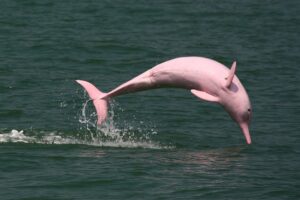
Amazon River Dolphin
Introduction to the Amazon River Dolphin The Amazon River Dolphin, known for its vibrant pink hue, is one of the

Discovering the Striped, Spotted, and Spinner Dolphins
These remarkable creatures belong to the family Delphinidae, which encompasses an array of dolphins, including the formidable killer whales and

Humpbacked Dolphin
Introduction to Humpbacked Dolphin Humpbacked dolphins are unique marine mammals known for their distinctive hump and are found in shallow,

Pilot Whale
Introduction to Pilot Whales Pilot whales are fascinating creatures that belong to the dolphin family (learn more about dolphins here),

The Piebald Dolphin (Commerson’s Dolphin)
Welcome to the enchanting world of Commerson’s dolphins, often affectionately called the “panda dolphins” due to their distinctive black and

White-beaked Dolphin
The white-beaked dolphin, a lively and fascinating marine mammal, captivates the attention of marine enthusiasts and scientists alike. Known for
